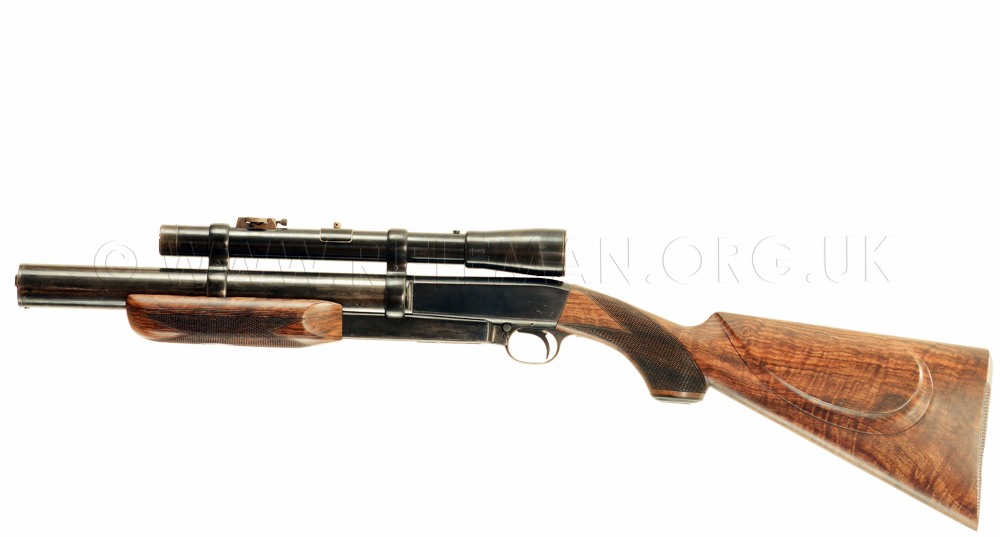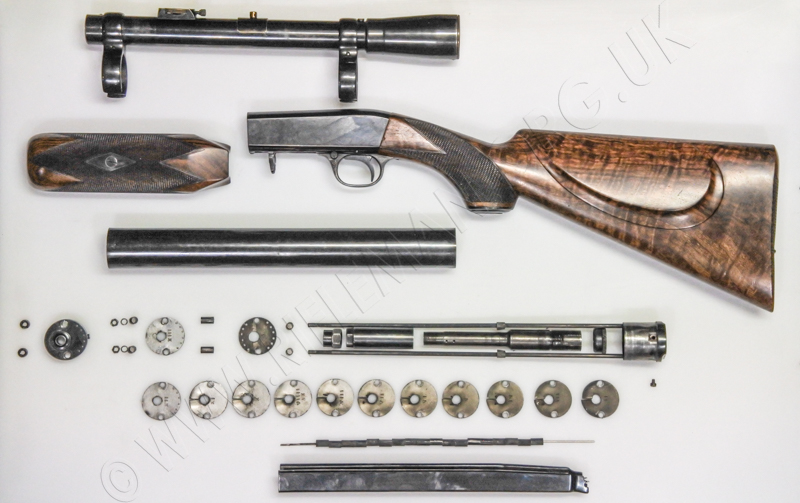BEST VIEWED ON PC.. - ....FREE OF COOKIES, TRACKING & ADVERTISEMENTS
The .22RF 'Prototype' of the
De Lisle Silenced Commando Carbine
See also the main page for the .45ACP calibre weapon
Please be aware that some specialist imagery may take time to load.
This site is designed for dedicated researchers, and is best viewed on desktop.
Designed and built by William Godfray De Lisle

De Lisle holding his personal carbine ca. 1980
From the defunct American "Gung-Ho" magazine 1984
Affording De Lisle's personal hand-built sporting carbine the descriptive adjective "prototype" may appear far-fetched, but this neatly packaged, diminutive, but effective "bunny basher" unwittingly became the seed for one of the Second World War's most unusual smallarms.
The next two images can be rotated and zoomed, either as initially loaded or full-screen for higher definition.
This carbine was De Lisle's personal concept, and was his adaptation of the ubiquitous lightweight Browning sporting semi-auto rifle for the purpose, between the wars, of quietly obtaining and putting food on the table. It was this inventive little carbine from which his WW2 Commando Carbine was eventually developed.
Hitherto, the only available photographs of this carbine have been two side elevations held by the National Army Museum, and those few photographs that were included in an article written about Geoffrey De Lisle by Robert T. Rome in 1984 for the U.S. "Gung-Ho" magazine, plus the relevant editions of Skennerton's Small-Arms Identification Series*.
We have used artistic means to generate imagery of the carbine from detail and measurements taken from those photographs. The carbine was retained by De Lisle for many years after the war, prior to its eventually finding its way to the Imperial War Museum in London. It was subsequently passed to National Army Museum for safekeeping, but sadly, ca. the Millenium, the carbine was no longer to be found at the N.A.M. and its whereabouts are now uncertain.
Before the conversion of the S.M.L.E. to the silenced "Commando" carbine, as we have said De Lisle designed and built certainly the .22 sporting carbine in the photos below and, it has been rumoured, possibly a second.
The carbine effectively became the prototype for the .45inch ACP (Auto Colt Pistol) calibre carbine when, after a need for such a weapon had been recognised at a high level in the clandestine services, Sir Malcolm Campbell heard of De Lisle's small-bore version, tested it, and immediately initiated the design and build of a full-bore pistol-calibre version.
In Ian Skennerton's excellent publications on the Special Service Lee-Enfields, he notes that the left-hand side of the Browning action was engraved with the text
"DE LISLE SILENT AUTO"
In fact, photographs held by the National Army Museum in London suggest that the carbine, once held by them on loan from the Imperial War Museum, has additional engraving.
The definition of their image is not good enough to decipher these markings, but we show the best close-up that we can process to illustrate the point. Our best guess is that the upper left-hand section is the text noted above; but there is further indistinguishable text to the right, and possibly a serial number centrally placed beneath.
As already mentioned, there has been speculation that De Lisle may at some point have built another of these carbines,either for himself, or for further trials, but we have nowhere seen confirmation of this.
The next three images are joint copyright to www.rifleman.org.uk and the National Army Museum.

The De Lisle silenced carbine in .22Rimfire

The carbine was hand built on the action of the famous Browning semi-automatic sporting rifle. A fairing-piece was added, below the forward part of the action, possibly structural or to support the rear of the fore-end and to protect the cocking-piece's modified and protruding operating flange in the ejection port. It is fastened to the front of the trigger-guard with one screw. The rifle was especially stocked with high-quality walnut and the fore-end and pistol-grip finely chequered.

The pair of figure-of-eight style split mounting brackets supported a telescopeoften reported to be of Periscopic Prism Company manufacture, as occasionally fitted to the No.1 SMLE sniper rifles used in the First World War. This would have been quite as expected, although many of these rifles and scopes again saw service in the 1939-45 War, significant numbers of the P.P.& Co. and Aldis Pattern 1918 telescopes were sold commercially as war surplus both between the two major conflicts and post WWII.
However, this identification may have been mistaken, or may have referred to an earlier example that was the one tested by Major Sir Malcolm Cambell. This would suggest confirmation of the rumour that De Lisle built a second carbine, and that this is the one photographed and later missing from the National Army Museum. Careful inspection of the photographs, and comparision with a number of other telescopic sight documentation, indicates the 'scope to be a "Fuess" model.
To demonstrate this we firstly we show an image of the Periscopic Prism Co. telescope on an SMLE .303 sniping rifle. You can also view imagery of a No.1 Mk.III sniper rifle fitted with an Aiming Tube for training practice via this latter link.
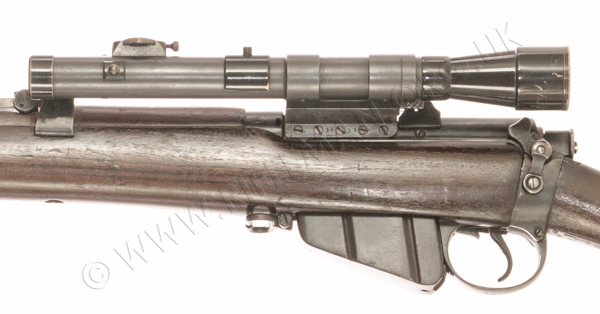
and now a contemporary advertisement for the Fuess Helio No.3 'scope
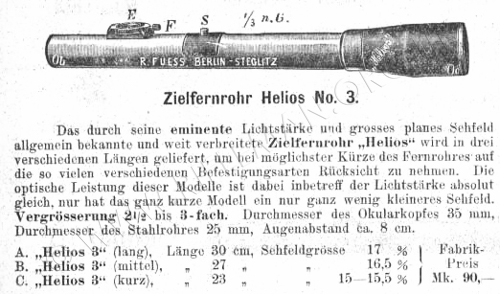
and a shot of the Helios 'scope, seemingly identical to that on De Lisle's .22 carbine, fitted to a rifle.

A contemporary reporton the De Lisle .45-inch calibre carbine, and other silenced weapons of the time, is held in the National Army Museum's archive. An extract from the report - which is available in its entirety on the page linked above - makes mention of the origin of the design for the "Commando" weapon.
20.12.45
DE LISLE COMMANDO CARBINE
Invented by William Godfray de Lisle, who was working for the Ministry of Aircraft Production, during the war. His first prototype was a .22 Browning
self loading rifle, which he modified and restocked, and was built in Beckenham in 1942-43. This rifle was mainly used for "quietly despatching small game on the Berkshire Downs, for the table at a time when meat was in short supply.
This prototype rifle is fitted with a 1st War vintage Periscopic Prism Co. telescope on overhead ring mounts.
Major Sir Malcolm Campbell came to hear of de Lisle and his rifle and inquired
of its effectiveness, so it was brought to London and fired from the top of
the Adelphi building into the Thames, and considered worthy of further development. Campbell asked for a 9mm model to be built up, which de Lisle did, but in reducing the velocity of the 9mm projectile by venting the barrel, problems arose with shavings from the projectile, and de Lisle considered that it lacked the desirable stopping power, recommended the .45 ACP round.
A prototype .45 de Lisle was assembled using an unserviceable No.1 action, at Bapty Co. workshop, and forwarded to Campbell for testing. It was found to have nil flash at night, and to be inaudible over 50 yards and non-typical of the sound of a firearm discharging. Campbell ordered a small batch for testing and use in clearing operations on the occupied French coast, as Campbell was with Combined Operations and involved in French coastal raids and clearance operations.
It should perhaps be mentioned that, although the telescopic sight of De Lisle's rimfire carbine was quoted in the above record as being made by the Periscope Prism Co., the telescope in fact fitted to the carbine was a Fuess Helios No.3 model made at Steglitz in Germany. At the time it was no doubt felt politically preferable to refer to the telescope as being of British manufacture.
_______________________-_
The STATISTICS
DATA TABLE |
|
FIREARM |
DETAIL |
| Designation or Type : | Silenced carbine |
| Action Type : | Browning semi-automatic |
| Nomenclature : | De Lisle carbine in .22 rimfire |
| Calibre : | .22-inch Long Rifle |
| Weight - empty: | 5 lbs. 14 ozs. (2.67 kgs) |
| Length - Overall : | 29.75 inches |
| Length - Barrel : | 6 inches |
| Furniture : | Walnut |
| Feed: | Tubular magazine in butt |
Magazine capacity: |
11 .22 Long Rifle cartridges |
| Rifling - No./Type of Grooves : | 6 |
| Rifling - Twist : | Right Hand - 1 turn in 16 inches |
| Sight - Fore : | None |
| Sight - Rear : | Fuess telescopic sight |
| Sight - Radius : | N/A |
We illustrate two outline and sectioned drawings associated with the specification for
the SMLE based .45 calibre De Lisle carbine and its patent.
This was presumably drawn using a similar moderator design to that of .22RF carbine that De Lisle himself built up, using the action from an FN Browning take-down .22RF semi-automatic sporting rifle of 'between the Wars' vintage.
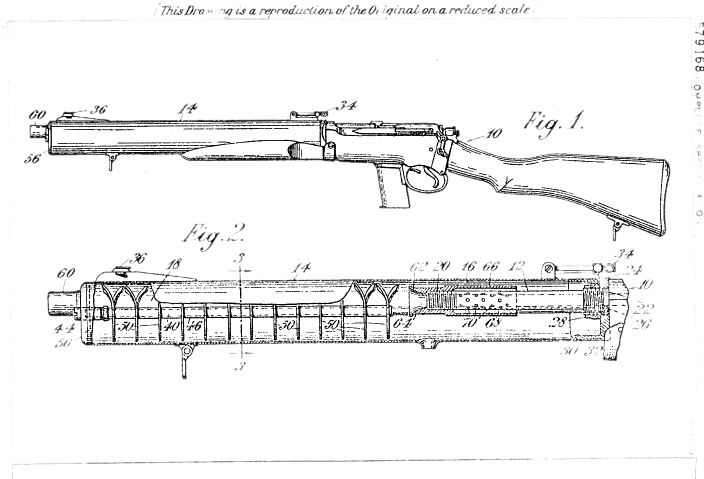
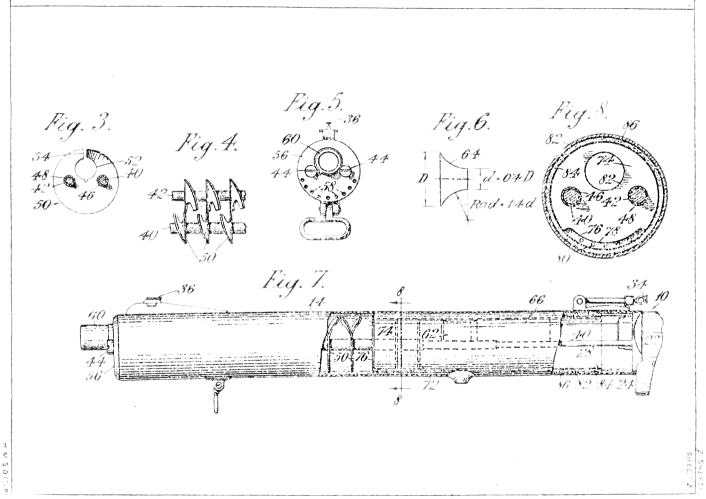
These drawings and the detail of the baffle assembly of the .22RF carbine
can be compared with the next two images, and those of the service calibre carbine and the Sterling Armaments' drawing on the page for the .45ACP calibre weapon.


Below: the disassembled .22 carbine.
Hover over or Click image to bring up hi-res file and magnifier
An apocryphal tale of one trial of the first De Lisle .45-inch calibre prototype is that the urgently required new weapon was completed overnight and taken to the London building of the Special Operations Executive (S.O.E.) first thing the following morning.
Impatient to discover its capabilities, it was test-fired at pigeons on the roof of a building opposite.
So quiet was the report, in the early part of the wartime "rush hour", that there was no reaction from passers-by. How the pigeons reacted was not reported; and neither is there any indication of concern for the fall of shot. Allegedly, the carbine was immediately despatched to the continent for further assessment (perhaps even a practical trial),
and further examples ordered on the spot.
However, as with many such anecdotes, whilst there is probably an element of truth in the above story, the veracious, and only marginally less thought-provoking version, came from the horse's mouth. Interviewed by Mr. Ian Skennerton in 1981, William de Lisle related how, during early "field-testing" of the suppressed carbines, they were fired at a large chimney across the road from the Wilkes gunmakers' premises at Beak Street near Piccadilly where prototyping was taking place*. The discharges were thereby proven to be "imperceptible" to those passing in the street below; the possibility of heavy hail notwithstanding!
One should perhaps remember that significant quantities of metal of all types were then falling from the skies over England, and the odd .45 calibre pistol round on a decaying trajectory, even had it been spotted, may barely have raised an eyebrow. Health and safety considerations were at the time hardly at the fore-front of general thinking.
Such testing was not unusual, as a reported wartime occurence in the No.79, Beak Street works of John Wilkes was during one of Geoffrey De Lisle's visits, initially with his personal .22RF calibre silenced carbine that is the subject of this page, and that became the catalyst for his following design for a .45-inch calibre silenced weapon intended for use by the Winston Churchill inspired Commando force.
The carbine was apparently fired down the corridor inside the works through the rear door in the direction of the outside privy. That this was not noticed by nearby neighbours was testimony to the effectiveness of De Lisle's moderator design.
More detail of the Wilkes Gunmakers' significant wartime activities can be found HERE
___________
Return to the main page for the De Lisle Silenced Commando Carbine
or view the comprehensive "Gung-Ho" magazine article of 1984
________________
* SPECIAL SERVICE LEE-ENFIELDS ... COMMANDO & AUTO MODELS - I. SKENNERTON - Small Arms Identification Series No.3
See also the Enfield Rifle No.4T sniper training rifle
Return to: TOP of PAGE
See this website's Raison d'être

